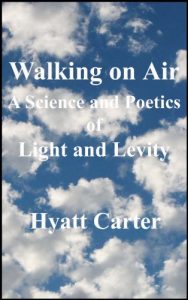From ancient times to the present moment, from mystics to quantum physicists, nothing has so fascinated, so perplexed, so captivated, and so mystified the mind as the elusive nature of light. Nobel Prize winner Richard Feynman felt an enchantment that would last for a lifetime when he heard his high-school physics teacher say: “Light always follows the path of the beautiful.” Early in his career Albert Einstein said, “For the rest of my life I will reflect on what light is!”
By “levity” I mean “lightness in mood, behavior, or word” as expressed in light-hearted humor . . . but, more importantly, I also mean “lightness in weight” and a counter-force that is the “opposite of gravity.” The quantum of gravitational energy, a hypothetical particle called the graviton, is balanced by the leviton, the particle of levity. Gravity makes things heavy, while levity make things light.
These essays are explorations of the many and wondrous workings of light and levity, and how they sometimes intertwine in luminous ways. For example, a photon, a particle of light, has no mass, making it the paragon of both light and lightness, or light and levity.
A few highlights:
It is light that says, “Let there be snowflakes,” for it is light, as the EMI or the electro-magnetic interaction, that mediates the step-by-step process of crystallization, and then holds the elegant patterns in place.
Self-organization and spontaneous pattern formation are ubiquitous in nature, and underlying it all is the EMI: mediating, communicating, in these productions of light.
Light and levity figure in Goethe’s powerful “new way of seeing” that allows one to cultivate and develop the cognitive equivalent of new organs of perception.
Photons, like some spies, lead two lives: the “real” photons that light up the world with vibrant color and “virtual” photons that briefly pop in and out of existence as they carry the electromagnetic force that plays a central role in the structure of matter.
Long, long ago, almost four billion years in the past, an event occurred, involving light, that has been called “one of the greatest works of creativity” in the entire history of the living earth. There were no humans around then . . . so “who” accomplished this amazing feat?
Leaping free in light and levity with a Zen master.
Enlightened dolphins and the levity of bubble rings.
“. . . like that waterfall on the upper Suli Gad that turns to mist before touching the earth and rises once again into the sky.”
Since I quoted two scientists in my opening paragraph, let me conclude with two quotes from Christian tradition, one ancient and one modern:
Duns Scotus: All that is, is light.
Cynthia Bourgeault: The kingdom of heaven is not later, it is lighter . . .
By “levity” I mean “lightness in mood, behavior, or word” as expressed in light-hearted humor . . . but, more importantly, I also mean “lightness in weight” and a counter-force that is the “opposite of gravity.” The quantum of gravitational energy, a hypothetical particle called the graviton, is balanced by the leviton, the particle of levity. Gravity makes things heavy, while levity make things light.
These essays are explorations of the many and wondrous workings of light and levity, and how they sometimes intertwine in luminous ways. For example, a photon, a particle of light, has no mass, making it the paragon of both light and lightness, or light and levity.
A few highlights:
It is light that says, “Let there be snowflakes,” for it is light, as the EMI or the electro-magnetic interaction, that mediates the step-by-step process of crystallization, and then holds the elegant patterns in place.
Self-organization and spontaneous pattern formation are ubiquitous in nature, and underlying it all is the EMI: mediating, communicating, in these productions of light.
Light and levity figure in Goethe’s powerful “new way of seeing” that allows one to cultivate and develop the cognitive equivalent of new organs of perception.
Photons, like some spies, lead two lives: the “real” photons that light up the world with vibrant color and “virtual” photons that briefly pop in and out of existence as they carry the electromagnetic force that plays a central role in the structure of matter.
Long, long ago, almost four billion years in the past, an event occurred, involving light, that has been called “one of the greatest works of creativity” in the entire history of the living earth. There were no humans around then . . . so “who” accomplished this amazing feat?
Leaping free in light and levity with a Zen master.
Enlightened dolphins and the levity of bubble rings.
“. . . like that waterfall on the upper Suli Gad that turns to mist before touching the earth and rises once again into the sky.”
Since I quoted two scientists in my opening paragraph, let me conclude with two quotes from Christian tradition, one ancient and one modern:
Duns Scotus: All that is, is light.
Cynthia Bourgeault: The kingdom of heaven is not later, it is lighter . . .






